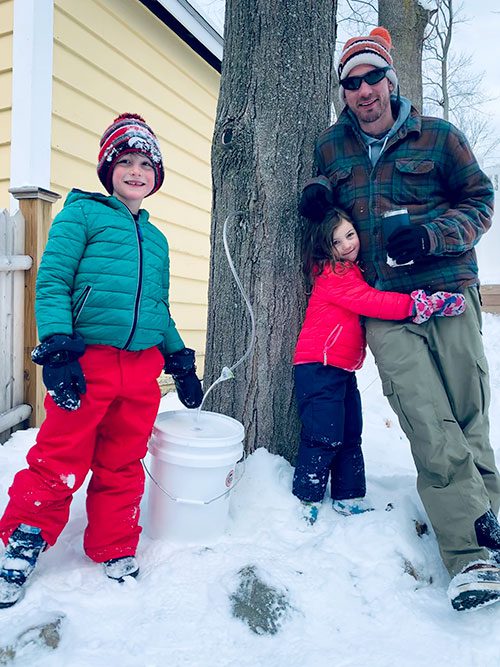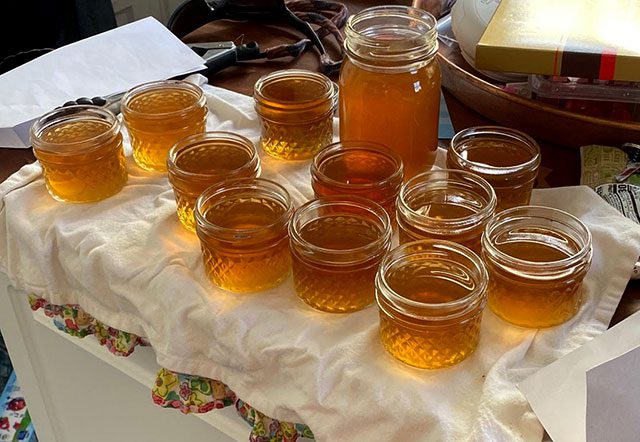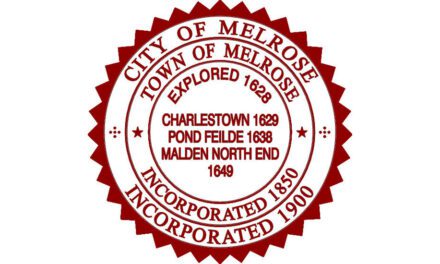Published March 26, 2021
By GAIL LOWE
MELROSE—How sweet it is for Kyle Block and his family to have not one, but four maple trees in their Hillside Avenue backyard. One is a sugar maple while the others are Norway maples, and they have this is common: each tree can be tapped for syrup.
According to Block, unlike sugar maples, a Norway maple is considered a “weed tree” as it is an invasive species which grows very quickly and can take over a habitat. Even so, they are still beautiful trees.
The other difference is that Norway maples produce less syrup per gallon of sap than what would be produced by a sugar maple.

“The sugar maple in my backyard is much more mature than the Norways,” said Block. “Two of the Norway maples are actually quite skinny but still have lots of sap.”
Block says the way to distinguish one type of maple a tree from another is by checking the varying number of lobes on the leaves. Some maples also have sharp, thin points while others have more rounded lobes, such as the Norway.
“If you’re really good at it, you can tell the difference between established maple trees by their bark,” said Block, adding that each maple also varies on the fruits (helicopters) and flowers.
Each of Block’s maples are between 40 and 50 feet in height, and in order to tap a tree for syrup, the diameter must be 12 inches or more.
“Once they’re big enough—about 20 inches in diameter—two taps (also called spigots or spiles) can be inserted in a tree, and once they get really, really big another tap can be added,” he said. Three of his trees have only a single tap while one tree has two.
So, just how did Block’s interest in tapping his maples start?
“When our trees were being trimmed five years ago, they started ‘crying,’” Block explained.
Around the same time, he and his family went to the Massachusetts Audubon Ipswich River Wildlife Sanctuary in Topsfield, which he called an “absolutely amazing place,” where big festivals and parties are held each year around maple syrup season. It occurred to Block that he could do the same at home.
“I ended up buying my first spile (tapping kit) there and four years later, I now tap all my trees,” he said.

Block, who has a big garden and loves to grow things, thought tapping for maple syrup would be something fun to do in winter and spring, the only time when the sap truly runs. He said that tapping a tree is as simple as drilling a one- or two-inch hole in the side and placing a spile—essentially a spigot for a maple—into the hole. The hole size varies based on the type of spile purchased. Then, the spiles are connected to tubes, which allow for the syrup to flow into a five-gallon bucket at the base of the tree. Then, all you have to do is sit back and wait. Under good conditions, Block will collect over five gallons of sap in a single day from his four trees.
The weather plays a large role in syrup production and requires overnight freezes, typically when the thermometer reads lower than 30 degrees and daytime temperatures rise to 40 degrees or higher. Block explained that the freeze/thaw cycle causes the tree to contract and essentially acts like a heart pushing the sap through the tree.
“This year seems to have been better than most because we’ve had a good three to four weeks of cold nights and warm days dating back to the end of February,” Block said. “Each week I’ve gotten about 10 to 15 gallons of sap.”
Fifteen gallons of sap might sound like a lot, but, for every 40 gallons of sap—and probably more like 60 for the Norways—it only makes one gallon of syrup.
“This is the part that amazes me,” Block said, referring to how nature can provide so much maple syrup. He also finds himself wondering who made the first attempt to make maple syrup, as boiling down ten gallons of sap into a quarter of a gallon takes a lot of time and even more so many years ago when propane burners were unheard of.
Block said that boiling needs to be done outside or in a sugar shack as all of the water has some sugar content and will completely encapsulate a house in “candy.” Historically, having a party to celebrate the all-day event of boiling the sap is common. “I started my last batch at about 8 a.m. and finally had syrup at 8 p.m.,” he noted.
Block confessed that he cheats and uses a propane burner, but “true chefs” use a fire pit that can be used for boiling. If this method is used, the fire must be maintained all day to ensure that the sap is boiling. Once the sap is boiled down sufficiently, it is then taken inside for finishing the boiling process.
‘You’ll know when to bring it inside when the viscosity increases, colors start getting stronger and you hit that approximate 40 to 1 ratio,” said Block. The final step is putting it on the stove top and keeping an extremely close eye on it while it continues to boil.
When the sap reaches 219 degrees (check with a candy thermometer), it becomes syrup. Last year, Block boiled the sap to a much higher temperature and poured it into ice cube trays while it was still hot. When the sap froze, it turned into delicious hard maple syrup candy.
“Once you taste fresh maple syrup, store bought is just not good,” Block commented. “You can actually drink fresh maple syrup. It tastes so good and is amazing over the top of ice cream or any of your traditional breakfast food groups.” Block’s children, Levon, 7, and Scarlett, 4, like to take spoonfuls here and there.
“We are close to 40 gallons this year,” said Block, adding that Levon and Scarlett’s teachers have had a taste and friends and family have been given little four-ounce jars.
“We keep only a little for ourselves,” Block said. “The rest we give away.”
Tree tapping kits can be purchased from the Massachusetts Audubon Society or at https://tapmytrees.com/.




